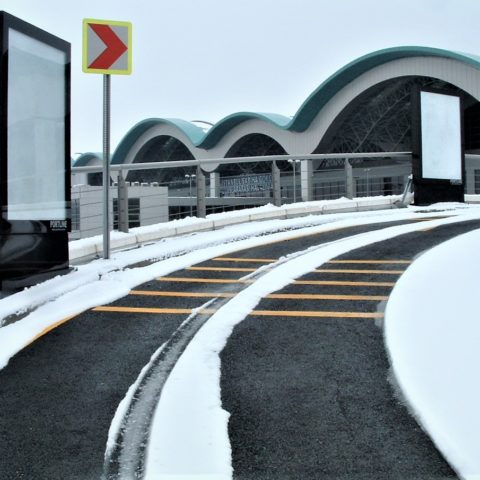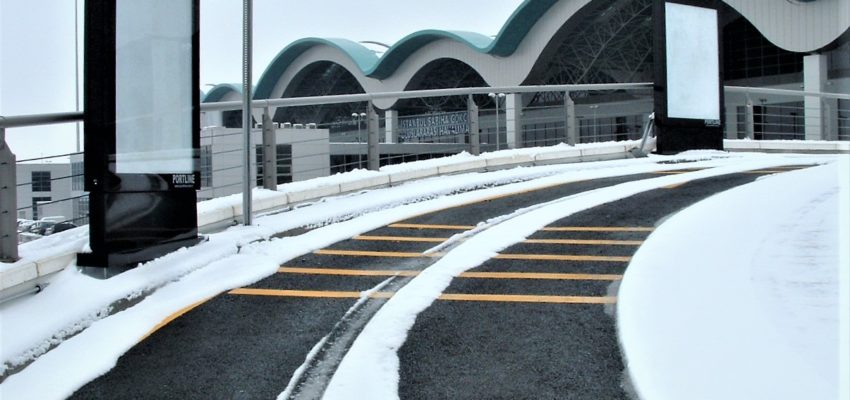Electrical snow melting systems reduce the need for chemical ice melters, which can be harmful to the environment. By eliminating the use of salt and other chemicals, snow-melting systems reduce the risk of soil and water pollution.
From car park access ramps and loading bays to pedestrian walkways and emergency escape routes, nVent RAYCHEM ramp-heating systems feature robust self-regulating heating cables, specially designed for embedding in concrete, sand or asphalt. Whenever the ambient temperature falls below 3°C (variable set point) and moisture is also detected by the ramp surface sensors, these cables power up and deliver just the heat required to keep the surface free of snow and ice. They are ideal for a wide variety of applications in exposed environments where it is essential to keep vehicular and pedestrian access available in freezing temperatures. Ramp heating can be used to prevent frost damage, maintain service continuity and enhance safety around commercial and public buildings and industrial sites. Complete systems, including nVent RAYCHEM ‘Smart’ controllers, are energy-efficient, easy to program and can be incorporated into building management systems.
Embracing Sustainable Winter Solutions: The Advantages of Electrical Snow Melting Systems over Chemical or Salt Deicing
Traditionally, chemical deicing and salt application have been the go-to methods for combating snow and ice. However, these methods come with a significant environmental cost. In recent years, electrical surface snow melting has emerged as a sustainable and eco-friendly alternative. In this blog post, we will explore why nVent RAYCHEM electrical snow-melting solutions are a more sustainable choice compared to chemical or salt deicing methods.
Minimizing Harmful Chemicals and Salts:
Chemical deicers often contain hazardous substances like calcium chloride and magnesium chloride, which can leach into the soil and nearby water bodies, causing environmental damage. These chemicals harm aquatic life and can also degrade infrastructure, leading to costly repairs. Additionally, the residues from these chemicals can negatively impact vegetation along roadsides.
On the other hand, electrical surface snow melting systems utilize electric radiant heat to melt the snow. There are no harmful chemicals involved, ensuring that our natural environment remains unscathed. This process reduces the risk of soil and water contamination, making it a more sustainable option.
Reducing Energy Consumption:
One common misconception about electrical snow-melting systems is that they consume excessive energy. While it is true that they require electricity to function, advancements in technology have made these systems significantly more energy-efficient. Modern electrical snow-melting systems utilize smart sensors and timers to activate only when needed. Additionally, renewable energy sources can power these systems, further reducing their carbon footprint and promoting sustainability.
Extending Infrastructure Lifespan:
Chemical deicers and salt can corrode road surfaces, bridges, and other infrastructure over time. As these substances seep into cracks and joints, they accelerate deterioration, leading to costly repairs and replacements. Electrical surface snow melting systems avoid this problem entirely. By relying on radiant heat, they do not introduce any corrosive agents to the infrastructure, thereby extending its lifespan. This means fewer repairs and less construction waste, ultimately contributing to a more sustainable infrastructure network.
Enhancing Pedestrian and Driver Safety:
Chemical and salt deicing methods can be effective in certain conditions, but they also have limitations. For instance, they are less effective at extremely low temperatures, and their effectiveness decreases as snow accumulates. Moreover, they often leave behind slippery residues after the snow has melted.
In contrast, electrical snow melting systems provide consistent and reliable snow and ice removal. They ensure that surfaces remain dry, reducing the risk of slips, falls, and vehicular accidents. Safer roads and walkways lead to improved public safety and well-being.
As we face the challenges of winter weather, it is essential to prioritize sustainable solutions that protect our environment and promote long-term well-being. Electrical surface snow melting stands out as a superior alternative to chemical and salt deicing methods. By minimizing harmful chemicals, reducing energy consumption, extending infrastructure lifespan, and enhancing safety, electrical snow melting aligns with our goals for a greener and more sustainable future.
By investing in electrical snow-melting technology, we can transform the way we combat winter’s icy grip, ensuring safer, cleaner, and more resilient communities for generations to come. Let us embrace this innovative approach and contribute to a more sustainable world.


